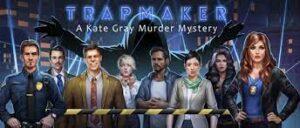The game I chose to play for this critical play was the Trapmaker story in the Adventure Escape Mysteries available on Steam. The game was developed by Haiku Games in 2020 and is available by the story on various gaming platforms for presumable 13+ audience.

Trapmaker is playable in chapters, with each chapter typically involving retrieving important information through clues left in typically one or two rooms. Information came in the form of 1) collectible objects such as maps and blueprints in the room/s hidden in plain sight or clickable compartments and 2) dialogues with characters in the narrative. The goal of the game is to uncover the perpetrator and motive behind the murder of a man by interacting with the various elements of the game.
Each ‘chapter’ consists of exactly one confined space within which collectible objects are clickable and can often be found inside a pocket or concealed at the bottom of suit case or other interesting hidden spots. These collected objects often helped me, as the player, understand parts of the story and the mystery better and aided in conducting interrogations of the suspects. This paced unlocking of the story often kept me hooked and stopped me from shutting the game due to frustrations with not finding hints quickly enough. 
The suspects were also interesting characters with gripping backstories with whom players can engage in conversation to further understand clues and unlock chapters. These characters and their backstories as well as their vividly illustrated settings and objects were incredibly effective in telling an interesting story. I think the game strikes a fine balance between revealing just enough information at every chapter for it to be satisfying but just little enough to fuel curiosity. For instance, chapter 1 culminates in solving a challenging puzzle and uncovering an important piece of information. However, this piece of information introduces a plot twist of sorts that makes me want to explore the next chapter.
These narrative elements together created 2 predominant types of fun: 1) challenge and 2) narrative. Part of the challenge was also figuring out what on the screen was actually clickable and understand what parts of the game were navigable, introducing discovery as another type of fun that works in tandem with the other 2 to make the game fun.
A standout element of the game is the ability to converse with suspects by clicking on interesting dialog prompts that give additional unrelated context about many of the characters. I think this makes the narrative flow more like a story and really creates an ecosphere around the game.




